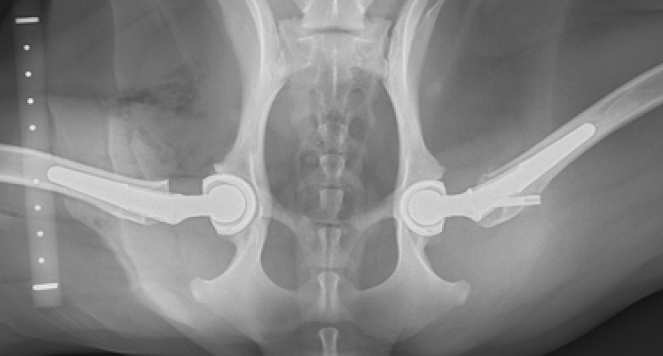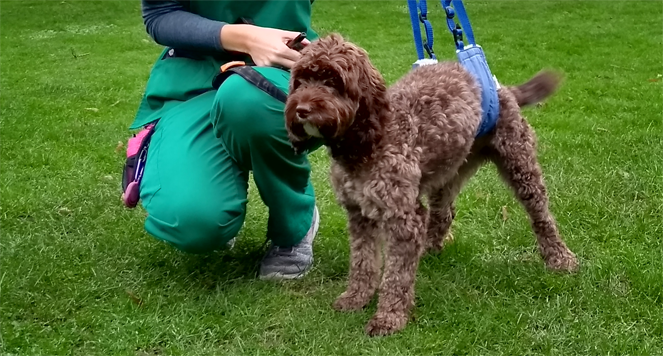Total Hip Replacement
Total hip replacement is the only treatment that fully restores life-long mobility and prevents recurrence of hip dysplasia. Besides hip dysplasia, other indications for total hip replacement also include non-reducible hip luxation, hip/physeal fracture, slipped capital femoral fracture, Leg Perthes Calve disease and old acetabular fractures.
Traditionally the technique has been performed in large and medium sized dogs however size is no longer a limiting factor. Cats and small dogs can now benefit from nano or micro hip replacement. Medium to giant sized dogs can also benefit from uncemented hip replacement, including the latest generation of bolted stems which limits complication such as subsidence of the stem.
Dogs are usually evaluated prior to surgery. Concurrent injuries such as lumbo-sacral or cruciate ligament disease are ruled out during that examination, risk and benefits of the surgery are discussed and x-rays are taken for surgical planning. The surgery is usually booked for a few weeks later, if not urgent.
Around 10% of cases experience complications. Eventually 95% of all patients who receive total hip replacement, recover full mobility.
What is involved?
The procedure involves replacing the ‘ball and socket’ components of the hip joint with an artificial cup and ball. We use the BioMedtrix hip replacement system which consists of modular cemented and cementless system. In cemented hip replacements the implants are secured using bone cement. Cementless hip implants ‘press fit’ and bone grows into pores in the implant surface. The choice of using a cemented or cementless system is based on the individual patient and surgeon.
Investigation
Following the orthopaedic assessment consultation, your dog will need to have a sedation or general anaesthetic for examination of the hips to further assess hip conformation and for radiographs to be obtained, which can then be used to plan surgery. Following this appointment surgery will be scheduled, often a few weeks later.
Surgery
Dogs undergoing Total Hip Replacement are admitted the day prior to surgery in order to be reassessed and ready for surgery early the following morning. If any signs of skin infection are found during preparation for surgery, the procedure must be postponed until these have resolved to reduce the risk of hip implant infections. In total, your dog is likely to be hospitalised for one to three nights depending on how comfortable your dog is following surgery.
Total Hip Replacement Surgery Complications
Based on current veterinary literature, total hip replacement carries a complication rate of 10-15%. Potential complications include seroma (wound swelling) or wound infection, aseptic (non-infected) loosening
of the implants, stem subsidence, hip dislocation, implant associated infection, fractures, ongoing lameness, sciatic neuropraxia (weakness of the operated leg due to irritation of the sciatic nerve) and the potential need for repeated (revision) surgery. Complications may result in a prolonged recovery or further surgery being required.
Aftercare
Aftercare following THR surgery is critical for a successful outcome. Your pet will be discharged with painkillers and antibiotics. Most dogs begin to use their operated limb on the day following surgery and are walking well within a couple of weeks. The joint capsule and muscle tendons which have been cut during surgery, will regain strength as they heal, this takes six to 12 weeks. During this time minor trauma (such as falling over) may result in tearing or stretching, and dislocation of the joint, which will require further surgery. A good result from the hip replacement surgery depends on preventing accidents and inappropriate activity.
Wound Care
Skin incision should be checked twice daily for two weeks following surgery or until the skin sutures have been removed. Licking or chewing of the surgical site can cause infection, and so we recommend that a buster collar is worn until the skin sutures are removed. If discharge or increased swelling is noted you should contact us and an examination may be necessary.
Other illnesses
Remember to take your dog to your veterinary surgeon promptly if you notice any signs of infection e.g. skin sores, diarrhoea, urinary problems, cough, ear problem, gum disease. If the hip replacement becomes infected, it will almost certainly not be possible to eliminate the infection without removing the prosthetic joint. If dental work is performed your dog should be pre-treated with antibiotics.
Physiotherapy
Can be very beneficial for recovery following total hip replacement.
Where suitable we will provide separate physiotherapy instructions.
Follow up appointments
We will request that you organise an appointment with your veterinary surgeon 10-14 days post-operatively for suture removal and assessment. We also request that you organise an appointment at Langford Vets six weeks post operatively for a check up. Post operative radiographs will be obtained at that time.
Conclusion
Total hip replacement surgery is commonly performed in cats and dogs at Langford vets. We will be very pleased to discuss the decision to proceed with surgery, what the surgery involves and any concerns you may have regarding THR surgery.





